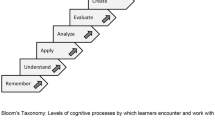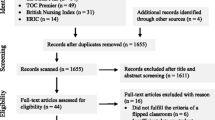Abstract
Technological advances have created immense pressure on our younger generation to keep themselves abreast with the newer developments in medical sciences. Educators have to evolve innovative pedagogy to help prepare this generation for future challenges as the training periods are getting relatively shorter. Flipped classroom or Inverted classroom is one such innovation that can empower a learner to develop critical thinking skills and master ways to imbibe vast information by engaging students in active learning process. Reading and understanding are carried at home, and the class-time is utilized for higher levels of learning like analyzing, evaluating, and application of the basic information. This review article is aimed to guide the educators in applying the concept of flipped classroom in their teaching learning armamentarium.
Similar content being viewed by others
References
Young TP, Bailey CJ, Guptill M, Thorp AW, Thomas TL. The flipped classroom: a modality for mixed asynchronous and synchronous learning in a residency program. West J Emerg Med. 2014;15:938–44.
Mazur E. Education. Farewell, lecture? Science. 2009; 323:50–1.
Walvoord BE, Anderson VJ. Effective grading: A tool for learning and assessment. San Francisco: Jossey-Bass; 1998.
Prober CG, Heath C. Lecture halls without lectures- a proposal for medical education. N Eng J Med. 2012; 366:1657–9.
Frenk J, Chen L, Bhutta ZA, Cohen J, Crisp N, Evans T, et al. Health professionals for a new century: transforming education to strengthen health systems in an interdependent world. Rev Peru Med Exp Salud Publica. 2011;28:337–41.
Modi JN, Gupta P, Singh T. Competency-based medical education, entrustment and assessment. Indian Pediatr. 2015;52:413–20.
Mahajan R, Badyal DK, Gupta P, Singh T. Cultivating lifelong learning skills during graduate medical training. Indian Pediatr. 2016;53:797–804.
Rowe M, Frantz J, Bozalek V. Beyond knowledge and skills: The use of a Delphi study to develop a technologymediated teaching strategy. BMC Med Educ. 2013;13:5.
Rose E, Claudius I, Tabatabai R, Kearl L, Behar S, Jhun P. The flipped classroom in emergency medicine using online videos with interpolated questions. J Emerg Med. 2016;51:284–91.
Lin Y, Zhu Y, Chen C, Wang W, Chen T, Li T, et al. Facing the challenges in ophthalmology clerkship teaching: Is flipped classroom the answer? PLoS One. 2017;12:e0174829.
Jensen JL, Kummer TA, d M Godoy PD.Improvements from a flipped classroom may simply be the fruits of active learning. CBE Life Sci Educ. 2015;14:ar5.
Moraros J, Islam A, Yu S, Banow R, Schindelka B. Flipping for success: evaluating the effectiveness of a novel teaching approach in a graduate level setting. BMC Med Educ. 2015;15:27.
Smith S, Ganesan R, Martin J. Flipping the practice based pathology laboratory-can it support development of practitioner capability for trainee pathologists in gynaecological cytopathology? J Cancer Educ. 2017;32:662–8.
Anderson LW, Krathwohl D. A taxonomy for learning, teaching, and assessing: A revision of Bloom’s taxonomy of educational objectives. New York: Longman; 2001.
Lockyer J, Ward R, Toews J. Twelve tips for effective short course design. Med Teach. 2005;27:392–5.
Stacy GS, Thiel SG. Use of Hyperlinks in PowerPoint Presentations as an Educational Tool. Acad Radiol. 2017; 24:1318–24.
Taylor AT, Olofson EL, Novak WR. Enhancing student retention of prerequisite knowledge through pre-class activities and in-class reinforcement. Biochem Mol Biol Educ. 2017;45:97–104.
Moravec M, Williams A, Aguilar-Roca N, O’Dowd DK. Learn before lecture: a strategy that improves learning outcomes in a large introductory biology class. CBE Life Sci Educ. 2010;9:473–81.
Vujovic P. Improving teaching skills: from interactive classroom to applicable knowledge. Adv Physiol Educ. 2016;40:1–4.
Strayer JF. How learning in an inverted classroom influences cooperation, innovation and task orientation. Learning Environ Res. 2012;1:171–93.
Tolks D, Schäfer C, Raupach T, Kruse L, Sarikas A, Gerhardt-Szép S, et al. An introduction to the inverted/flipped classroom model in education and advanced training in medicine and in the healthcare professions. GMS J Med Educ. 2016;33:Doc46.
Azer SA. Understanding pharmacokinetics: are YouTube videos a useful learning resource? Eur Rev Med Pharmacol Sci. 2014;18:1957–67.
Margolis AR, Porter AL, Pitterle ME. Best practices for use of blended learning. Am J Pharm Educ. 2017;81:49.
Ramnanan CJ, Pound LD. Advances in medical education and practice: student perceptions of the flipped classroom. Adv Med Educ Pract. 2017;8:63–73.
Marrs KA, Novak G. Just-in-time teaching in biology: Creating an active learner classroom using the internet. Cell Biol Educ. 2004;3:49–61.
Gillispie V. Using the flipped classroom to bridge the gap to generation Y. Ochsner J. 2016;16:32–6.
Lockman K, Haines ST, McPherson ML. Improved learning outcomes after flipping a therapeutics module: results of a controlled trial. Acad Med. 2017;92:1786–93.
Barkley EF, Cross KP, Major CH. Collaborative Learning Techniques: A Handbook for College Faculty, 2nd Edition. San Francisco: Jossey-Bass; 2014.
Clark RM, Besterfield-Sacre M. Assessing flipped classrooms. In: Reidsema C, Kavanagh L, Hadgraft R, Smith N (eds). The Flipped Classroom. Singapore: Springer Singapore; 2017. p.57–74.
Tainter CR, Wong NL, Cudemus-Deseda GA, Bittner EA. The ‘Flipped Classroom’ model for teaching in the intensive care unit. J Intensive Care Med. 2017;32: 187–96.
Jump C, Sahn B, Wendel D, Augustine M, Fish S, Albenberg L, et al. Using fellows to implement a ‘flipped classroom’ on an inpatient pediatric rotation. Journal of Family Medicine and Community Health. 2017;4:1112.
O’Donnell JF. The Khan Academy: a great opportunity for cancer education. J Cancer Educ. 2012;27:395–6.
Sheppard ME, Vitalone-Raccaro N, Kaari JM, Ajumobi TT. Using a flipped classroom and the perspective of families to teach medical students about children with disabilities and special education. Disabil Health J. 2017;10:552–8.
Kim MK, Kim SM, Khera O, Getman J. The experience of three flipped classrooms in an urban university: an exploration of design principles. Internet and Higher Education. 2014;22:37–50.
Schwartzstein RM, Roberts DH. Saying goodbye to lectures in medical school - paradigm shift or passing fad? N Engl J Med. 2017;377:605–7.
Author information
Authors and Affiliations
Corresponding author
Rights and permissions
About this article
Cite this article
Singh, K., Mahajan, R., Gupta, P. et al. Flipped Classroom: A Concept for Engaging Medical Students in Learning. Indian Pediatr 55, 507–512 (2018). https://doi.org/10.1007/s13312-018-1342-0
Published:
Issue Date:
DOI: https://doi.org/10.1007/s13312-018-1342-0




